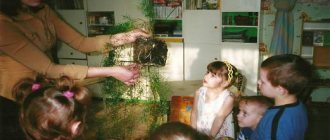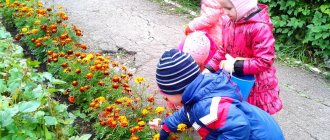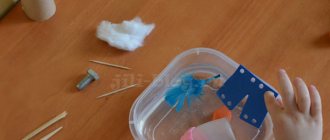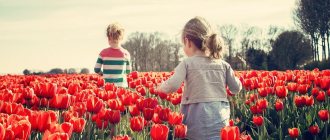Methodological development “Methods of environmental education of preschool children”
The next verbal method is reading works of fiction.
In the hands of a teacher, a children's book about nature has great educational value. It expands children's understanding and introduces them to phenomena that are impossible to directly perceive. A natural history book reveals to children the phenomena of inanimate nature, helps to establish connections and relationships that exist in nature.
The founders of Soviet children's natural history books are V.V. Bianchi, M.M. Prishvin, Paustovsky, Sladkov. Pavlova introduced a new genre - environmental fairy tales, which in a fascinating way introduce the creatures inhabiting planet Earth, teach us to understand their needs and relationships, and reveal the secrets of complex phenomena and miraculous transformations in nature. The ecological fairy tale was further developed by Shorygina and Ryzhova.
Practical methods.
One of the practical methods of environmental education is play.
While playing, children learn about the natural environment, their knowledge about objects, objects, and natural phenomena noticeably expands and becomes more specific.
Play activities also have an impact on the development of children’s humane feelings towards nature and their cognitive attitude towards it.
A special place and importance in the system of environmental education for preschoolers is occupied by didactic, that is, educational games.
Didactic games are games with ready-made content and rules. In the process of didactic play, children clarify, specify, consolidate, expand, and systematize their ideas about nature. At the same time, the didactic game influences the development of preschoolers’ mental operations (such as analysis, synthesis, comparison, generalization, classification, etc.)
In the process of environmental education of preschoolers, the following types of didactic games are used:
subject;
desktop-printed;
verbal;
creative.
Didactic games should be used starting from the younger age group.
Creative games are of great importance in the system of classes with children on environmental topics.
Construction games with natural materials
(sand, water, clay, cones, pebbles, etc.). They have a positive impact on the process of children learning specific properties and qualities of natural objects. In the process of these games, children’s sensory experience is enriched, improved, and cognitive abilities are developed. Construction games can also be used to prepare children for practical research activities, since during these games children often learn problem situations related to the physical properties of materials (for example, why dry sand crumbles, but wet sand can be used to make Easter cakes).
Practical methods
Play is a method by which children get acquainted with the world around them. The younger the children, the more often the game is used as a method of educational work. Outstanding teachers (Leontyev, Elkonin, Zaporozhets). called play the leading activity of preschoolers?
Didactic games are games with rules that have ready-made content. In the process of didactic games, children clarify, consolidate, and expand their existing ideas about objects and natural phenomena, plants, and animals. Games give children the opportunity to operate with objects of nature, compare them, and note changes in individual external signs. Many games lead children to the ability to generalize and classify, and evoke an emotional attitude towards nature.
Printed board games are games such as lotto, dominoes, cut and paired pictures (“Zoological Lotto”, “Four Seasons”, “Plants”, “Pick up a Leaf”, etc.).
In these games, children’s knowledge about plants, animals, and inanimate natural phenomena is clarified, systematized, and classified.
Word games are games whose content is a variety of knowledge that children have and the word itself. They are carried out to consolidate children’s knowledge about the properties and characteristics of certain objects. These are games like “Who flies, runs and jumps?”, “What kind of bird is this?”, “When does this happen?”, “In the water, in the air, on the ground”, “Necessary - not necessary”, etc.
Outdoor games of a natural history nature are associated with imitation of the habits of animals and their way of life. By imitating actions, imitating sounds, children consolidate knowledge; The joy gained during the game helps to deepen interest in nature. For example, such games as “Hen with Chicks”, “Mice and Cat”, “Wolf and Sheep”, etc.
Experimental games allow you to verify the authenticity of physical and natural phenomena and patterns (“Drowning - not drowning”, “Soap bubbles”, “Let’s make solutions”, “Which water is easier to swim in”). In older groups, competitive games and travel games can be successfully used.
Experiments are observations carried out in specially organized conditions. They are used for children to establish certain phenomena, connections, relationships between objects and natural phenomena. The experiment can take place either as a long-term comparative or as a short-term observation. The final point of the experiment is the formulation of conclusions based on the results obtained. The teacher encourages children to form their own conclusions.
Experiments that can be carried out with children (a branch in a cool and warm place (depending on heat); a plant in a dark and light place (depending on lighting); a plant with and without water (the need for water for growth), etc.) In progress When organizing experiments, living objects must not be brought to death or their vital manifestations disturbed.
Therefore, as soon as noticeable changes appear. The conditions must be changed immediately. Experiments contribute to the formation of children's cognitive interest in nature, develop observation and mental activity. In each experiment, the cause of the observed phenomenon is revealed, children are led to judgments and conclusions.
Experiments are of great importance for children’s understanding of cause-and-effect relationships. Experiments are most often carried out in older groups of kindergarten. In the junior and middle groups, the teacher uses only individual search actions. Experience should always be built on the basis of existing ideas that children received in the process of observation and work. Its task and purpose should be clear to preschoolers.
Modeling is considered as a joint activity of the teacher and children to build models. The purpose of modeling is to ensure that children successfully acquire knowledge about the characteristics of natural objects, their structure, connections and relationships that exist between them. It is based on the principle of replacing real objects with objects, schematic images, and signs.
What is S.N. Nikolaeva’s book about on methods of educating preschoolers about ecology?
Svetlana Nikolaevna Nikolaeva is a Doctor of Pedagogical Sciences, chief researcher at the Institute of Psychology, dealing with childhood problems. The author of scientific works on pedagogy is known for her research related to environmental education. She reveals this topic in her work “Methods of environmental education of preschool children.”
Palms holding children and rainbow
The textbook was written by a person with extensive experience in raising children. According to Nikolaeva S.N., environmental education should begin with stories about nature. And when the child’s consciousness is filled with the necessary information, it is possible to consolidate in the pupil a certain attitude towards the environment:
- educational;
- aesthetic;
- humanistic.
Important! Nikolaeva S.N. “Methods of environmental education of preschool children” is a work in which the author expresses confidence: a person’s attitude to the natural environment is an indicator that shows how educated he is in environmental terms. And it is important to start such education as early as possible, from the preparatory group of kindergarten, consolidating it in the middle and senior groups.
The teacher proposes a method of environmental education, which consists of two main points:
- transfer knowledge on ecology;
- modify them into relationships.
Environmental education of Nikolaeva’s preschoolers should be about achieving the final result when the child consciously treats nature with care. Realizing that he too is part of this environment.
Planet with a butterfly in human palms
Forms of environmental education
- Lesson . The most basic and most common form of work on environmental education of children is the lesson. He also classes (GCD) in kindergartens. In support of environmental education, such a subject as the surrounding world was created, which introduces children to living and inanimate nature, its laws, and the basics of environmental protection.
Lessons (activities) allow the teacher to develop children's knowledge about nature, taking into account their age characteristics. There are several types of classes:
- Initial informational. Such lessons (lessons) have an introductory function, that is, they introduce children to certain species (animals, birds, fish, etc.), their living conditions, natural phenomena, and basic concepts about the environment. The necessary material for such activities (lessons, conversations) are visual materials (demonstration aids, posters, films);
- Generalizing. Allows children to form general concepts about certain types and natural phenomena, the ability to identify their common features (senior preschool and primary school age);
- In-depth cognitive. Classes (lessons) that are based on previously acquired knowledge. Deepening what has already been learned, applying it in practice - such lessons are conducted in the form of a conversation, a quiz, or watching a video in class.
- Ecological holidays. Activities that are classified as extracurricular activities. They can be either timed to coincide with calendar holidays (Earth Day), or independent, invented by teachers. The purpose of such leisure is to evoke a positive emotional response in children, which in turn awakens interest in environmental problems. When drawing up an entertainment script, material that is already familiar to children is used.
- Excursions . Starting from the middle group of a preschool educational institution and ending with the middle classes of a comprehensive school, an excursion is one of the most effective forms of work on environmental education of children. And this is understandable. No matter how much we talk, no matter how many conversations we have, nature is an environment that can only be experienced by coming into direct contact with it, in a natural setting. The teacher conducts excursions in accordance with the requirements of the state educational program, previously indicating goals and objectives in the calendar plans.
- Labor It would be strange not to indicate this form of direct combination of human activity with environmental protection. In kindergartens, this is caring for living corners, flower beds, small vegetable gardens, organized by educators for the purpose of environmental education of children. At school, this means cleaning the area, watering, caring for plants, and working on the school site (especially common in rural schools).
- Participation in school city competitions and olympiads. Such competitions are often held both by the schools themselves to strengthen motivation among students, and by the city administration. Site reviews, quizzes, olympiads - all this awakens the spirit of competition, and, as a result, provides significant motivation for environmentally oriented detail among children of primary and senior school age.
- Working with parents. A full educational effect is achieved when school and family act in the same direction. Therefore, working with parents is one of the most important forms of environmental education. Consultations for parents, participation in school events, experiments conducted by children together with their parents (at home, in the country, in the village), participation of parents in shows and exhibitions are techniques that are necessary for fruitful work.
Book by Nikolaeva S.N. environmental education of preschool children - methodology
Preface
The progress of modern civilization is largely due to the rapid development of natural science, in particular, the biosphere sciences, in which all earthly processes are considered in interconnection, in the unity and interdependence of their manifestations. Ecology among these sciences acquires special significance.
In recent decades, the development of two parallel processes has been clearly visible - the worsening of the planet’s environmental problems and their understanding by the Earth’s population. In Russia, as in other countries, a system of continuous environmental education is being established, and a conceptual vision of this process is being formed. The initial link in the environmental education system is the sphere of preschool education.
It is obvious that it is at the stage of preschool childhood that the first worldview is formed: the child receives emotional impressions of nature, accumulates ideas about different forms of life, that is, the fundamental basis of ecological thinking and consciousness is formed, and the initial elements of ecological culture are laid. But this happens only on the condition that the adults raising the child themselves have an ecological culture: they understand universal problems and are concerned about them, show the child the beautiful world of nature, and help establish relationships with him.
This monograph presents a theoretical (philosophical, natural science and psychological-pedagogical) justification for the methodology of environmental education of children, which, although new, has already entered the educational space of preschool institutions. Based on many years of research by the author and his students, it is shown how the content of environmental education for children crystallizes, what mechanisms ensure its implementation, and contribute to building the foundation of environmental culture.
The research began in the 70s of the 20th century: a preschool natural history group was created in the psychological and pedagogical laboratory of mental education of the Scientific Research Institute of Preschool Education of the Academy of Pedagogical Sciences of the USSR. The direction is headed by Candidate of Biological Sciences (later Doctor of Psychological Sciences) K. E. Fabry. The laboratory creates a synthesis of sciences - preschool pedagogy, child psychology and natural science - that is effective for building a system of environmental education for preschool children.
Like all members of the laboratory, the group’s researchers are aimed at finding new content for teaching preschoolers - content that reflects the leading patterns of the surrounding reality and can intensively develop children’s mental abilities. The basis of the new content in the group’s developments is the universal pattern of nature – the unity of the organism and the environment. This pattern is observable, as it has clear external manifestations that reflect the adaptive relationship of all living things with their environment. A pattern can also be found in the ontogenesis of organisms, and its phylogenetic result is the diversity of living beings. The idea of new content in introducing preschoolers to nature, approved by colleagues, was first presented in the 1972 monograph “Mental Education of Preschoolers.”
Since the late 70s, dissertation research has been completed one after another (S. N. Nikolaeva, A. M. Fedotova, T. V. Khristovskaya, L. S. Ignatkina, I. A. Komarova). During these same years, research on this problem was carried out in other institutions of the country, in particular, in Leningrad - at the Leningrad State Pedagogical Institute named after. A. I. Herzen at the Department of Preschool Pedagogy (P. G. Samorukova, I. A. Khaidurova, E. F. Terentyeva, N. N. Kondratyeva). By the 90s, many interesting facts had accumulated, reflecting the ability of preschool children to acquire new content of knowledge about nature; researchers are getting interesting results about the way children learn. An analysis of the accumulated material is presented in the general work of S. N. Nikolaeva “Communication with nature begins in childhood” (1992). The monograph becomes a theoretical foundation on which it is already possible to build the “infrastructure” (program and methodological support) of a new area of preschool pedagogy - environmental education.
In 1993, the first “Program of Environmental Education for Preschool Children” was published, which, subsequently refined and expanded, became the “Young Ecologist” program. In 1996, the “Concept of Environmental Education for Preschool Children” was published, which outlines all the key positions: content and methods of environmental education; pedagogical synthesis of educational and educational components (knowledge and attitude); the role of the teacher as a carrier of ecological culture; scheme for managing environmental education. The task arises of creating methodological manuals that will allow introducing a new approach to introducing children to nature into preschool institutions. In 1995, the first technology “Education of environmental culture in preschool childhood” was released for working with children of the preparatory group under the “Young Ecologist” program. This book is the first in a series of teaching aids (technologies) for working with children of senior and middle groups, and junior preschool age. The concept and program, combined with technology, allow any preschool institution to implement a system of introducing children to nature in a new – ecological – key.
In the 90s, research continued: T. A. Fedorova tested a new - environmental-economic - aspect of the content of the methodology, the possibility of implementing initial environmental management in kindergarten. T. G. Tabukashvili’s research reveals the conditions for the formation and development of professional ecological culture of students in the preschool department of a pedagogical college. These conditions are: a course of a new methodology - methods of environmental education, an environmentally-developing environment of an educational institution and a cycle of extra-curricular activities of an environmental nature.
Further research in the field of environmental education of preschool children concerns adults raising children and creating conditions for the formation of the beginnings of an environmental culture in them. This is a publication of textbooks that allow students of pedagogical colleges and universities to master a new methodology and acquire an ecological worldview, as well as the development of a manual that addresses issues of management, setting up methodological work with the teaching staff and creating an environmentally-developmental environment in a preschool institution. Taken together, these materials make it possible to put into practice the concept of “The educator is the bearer of ecological culture.” The publications embody the author’s vision of the system of environmental education for preschool children.
The author expresses gratitude to all the employees of the Institute of Preschool Education, who in one way or another supported the research of the preschool natural history group and participated in their promotion. Special thanks to Academician, Doctor of Psychology, Professor Nikolai Nikolaevich Poddyakov, who first as the head of the laboratory and then the director of the institute for many years supported research in this area and ensured a high level of content of scientific work.
Any research needs to be verified by practice, therefore, since the release of the first “Program of Environmental Education for Preschool Children,” fruitful cooperation has been developing with a number of preschool institutions in Moscow. For many years (more than 15 years) of joint work, the author expresses gratitude to the District Education Departments and teaching teams: Preschool Educational Institution No. 1012 SEOU (headed by G. S. Ivanova), Preschool Educational Institution No. 1691 Higher Educational Institution (headed by T. M. Novikova), Preschool Educational Institution No. 403 SVOU ( leader T.N. Zenina). Year after year, in an experimental mode, these institutions are testing: the content of environmental education presented by the “Young Ecologist” program, new methods and forms of organizing work with children, environmental and pedagogical technologies for different age groups, a scientific and methodological seminar as a form of advanced training for children’s teachers garden
The author also expresses gratitude to all the practitioners in Russia who to this day are introducing the “Young Ecologist” program and methodological support for it into the work of preschool institutions.
Thanks to the organizers of all-Russian conferences that contributed to the dissemination of the ideas of environmental education of preschool children: former leading specialist of the Ministry of Natural Resources N. F. Tsertsik, member of the board of the presidium of the All-Russian Society for Nature Conservation V. I. Efimova.






